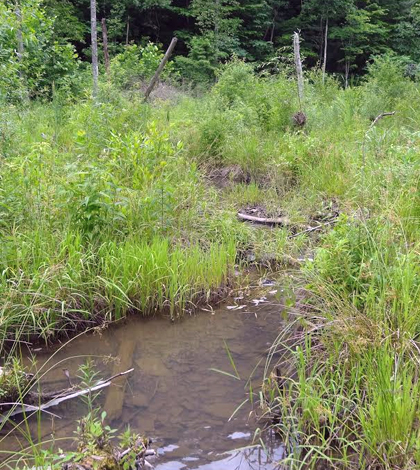U. Of Louisville Scientists Assess Stream Restoration Methods

A restored stream site in the Daniel Boone National Forest. (Credit: Jesse Robinson / University of Louisville)
A lot of work goes into stream restoration projects, but how do you know if all the effort is yielding ecological benefits? That is one of the many questions that researchers are tackling at the University of Louisville Stream Institute.
To get at the answer, they have devised experiments that compare conditions in restored streams to others that have not been remediated or will be soon. These unrestored streams help to serve as baselines for comparisons that could inform new stream restoration methods in the future.
Researchers routinely track streams for important parameters relating to stream health, including temperature, dissolved oxygen, conductivity and suspended sediments. But they also learn a lot just from gauging a stream’s depth, for which they typically use pressure transducers.
“We are primarily using the APG PT-500 (transducers) in sites which have been or will be restored to a stream-wetland complex using valley restoration techniques, as well as similarly situated sites, unrestored sites which represent a baseline condition for comparison,” said Jesse Robinson, research project engineer at the stream institute. “We are working on a project for the Environmental Protection Agency (Region 4) where we will use data from all of these sites to develop stream restoration assessment methods.”
Those sites are mostly in Kentucky, in steep streams that have varying sediment characteristics. Whereas some are dominated by sand, others are more filled with silt or clay. The unrestored streams can sometimes transport boulders during large flood events, he says.
By continuously measuring depth in the streams, researchers and staff at the institute can keep an eye on flooding as well as other hydrologic conditions that the sites can experience, like drying out or receding.
“These conditions are the foundation for everything that occurs within the stream, including, for example, whether habitat and food sources will remain in place for aquatic life or be scoured during floods,” said Robinson.
Data on depth they’ve collected have revealed some insights about the streams under study in Kentucky, as well as a few surprises.
“We were aware that small, frequent floods were moving aquatic habitat around in some of our un-restored sites, but we were surprised to see how frequently — seven times and counting in a single year — this was happening,” said Robinson. “We do not see this movement in our nearby restored sites. The APG PT-500 helps us understand the kinds of floods we are seeing in terms of their frequency, duration and magnitude, which we pair with bedload transport sensors to know when aquatic habitat is moving.”
Top image: A restored stream site in the Daniel Boone National Forest. (Credit: Jesse Robinson / University of Louisville)




0 comments